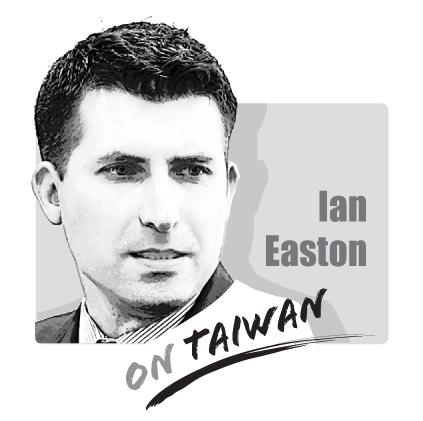Today the island nation of Taiwan is watching China’s shadow close in. But there is still time for the United States to help keep the beacon of democracy burning bright.
The Republic of China, more commonly known as Taiwan, is on the front lines of the free world’s strategic standoff with the People’s Republic of China. It’s a lonely place to be, especially when facing a brutal giant whose brains and bankrolls are just as impressive as his guns.
By virtue of its shared values and strategic location, Taiwan is essential to the American-led international order. However, the island’s liberal government and territory are under threat. China is growing increasingly powerful and its leadership is seething with hostility. What’s worse, Washington has been dysfunctional and slow to extend a helping hand.

Make no mistake about it; General Secretary Xi Jinping (習近平) has become a dangerous dictator. He has severed the Chinese people’s access to basic human rights. He has shattered their hopes and dreams of political reform. He has scorned rule of law. Under Xi’s leadership, the Chinese Communist Party (CCP) is now boot stomping its way into an ugly Orwellian future.
The armed wing of the CCP, the People’s Liberation Army (PLA), is driven by an offensive military concept they call the Joint Island Attack Campaign (大型島嶼聯合進攻戰役). That’s code for the plan to launch a war of aggression against Taiwan.
To this end, China is racing flat out in its military buildup. The objective is a red flag with five yellow stars flying over every building left standing in Taiwan once they are done hammering the defenders into submission. Chinese generals envision a new world order where the prestige, power, and confidence of the United States have crumbled into dust. Annexing Taiwan is the first step.
The Chinese military is not a unitary actor. PLA officers work hand in glove with civilian intelligence operatives, shady financial organizations, propaganda outlets, united front groups, cyber hackers, and organized crime syndicates.
Xi understands that it is imperative to leverage every element of power. He knows that the battle of the mind comes before the battle of the fist. Taiwan would be almost impossible to successfully invade if the Taiwanese people stood united. For Xi, destroying their will to fight is critical.
The Taiwanese are being subjected to psychological warfare. They are being bombarded by weapons that draw no blood, but weaken nerves. Every day their televisions and computer screens are lit with images of hostile warplanes circling their island, Chinese spies being hauled off to jail, and pro-unification groups rioting outside their parliament. They watch as one diplomatic partner after the next betrays their trust and succumbs to Beijing’s dollar diplomacy.
Less visible, but no less pernicious, is the money changing hands between Chinese officials and major international corporations, lobbying firms, consultancies, universities, think tanks, movie studios, and newspaper empires. This money buys the Chinese Communist Party the ability to distort the truth and silence anyone who might otherwise voice support for Taiwan.
Any serious threat to Taiwan’s survival is a threat to US national security. But it is far from clear that this is well understood by most Americans. Officials in the Trump administration, like their predecessors before them under Obama and Bush, have mostly been unwilling or unable to stand up to China over Taiwan. Nothing is as demoralizing to the Taiwanese as watching the American superpower wilt in the face of intimidation.
US government officials have repeatedly called on Taiwan’s government to raise defense spending and treat the threat from China with a greater sense of urgency. Their wise calls to action, however, ring hollow when Washington is not willing to step up and put skin in the game.
Some American policymakers favor taking the easy route. They would rather support Taiwan in a minimalist, low-key fashion. They loathe to do anything that might draw snarls from Beijing.
Their proposed solution is something called the porcupine strategy. This strategy calls for limiting the most lethal (and often most expensive) weapons in Taiwan’s arsenal, including stealthy submarines, jet fighters, land attack cruise missiles, and main battle tanks. Porcupine fans propose that Taiwan go all-in on massive stockpiles of cheap coastal defenses like sea mines, missile fast boats, short-range air defenses, and anti-tank rockets.
President Tsai Ing-wen (蔡英文) and her generals seem to be in agreement that such a strategy would sacrifice their strategic capabilities to deter or win war in a blind pursuit of quick and easy operational improvements. They can see that it’s not an either-or question. Any strategy that focuses on taking tools out of the tool box, instead of expanding and sharpening them, is deeply flawed.
Taiwan needs cutting-edge weapons systems to keep its air force, navy, and army strategically competitive over the long run. It also needs a larger arsenal of small, mobile, and smart systems for point defense in case all else fails. By employing a special budget, Taipei can afford to have both.
But Taiwan cannot be expected to work military miracles all on its own. The threat to Taiwan, and by extension all democracies in the Indo-Pacific, is real. It’s a mistake to limit Taiwan’s national security options, yet that is precisely what three consecutive US administrations have sought to do.
This makes America’s forward line of defense against Chinese expansionism weaker. It places a greater burden on US forces for Taiwan’s defense. It encourages Xi Jinping to take risks and destabilize the region. It lowers the costs on our strategic rival when we should be raising them.
Going forward, American policymakers would do well to lead from the front, instead of seeking to place the onus for keeping the peace entirely on Taiwan. For all their many strengths, the 23 million citizens of Taiwan cannot be expected to defend the center of the first island chain against China all by themselves.
At this point, there is so much room for improvement in US-Taiwan defense and security relations that even small gestures of support would be a big deal.
One thing that President Trump could do immediately to signal strength in the face of Chinese coercion would be to order a US Navy warship to transit the Taiwan Strait. He could then tweet about it, publically showing the world that these are still international waters.
This action should be followed by Taiwan port visits, general officer and flag officer visits, high-profile arms sales, bilateral military and coast guard exercises, and a beefed-up American military presence at the American Institute in Taiwan and as advisors on Taiwanese bases.
The fact that some in Washington are afraid to even seriously consider doing many of these things says a lot about how far the Chinese Communist Party’s influence operations have succeeded in hardening hearts and weakening minds and/or backbones across American society.
Let’s hope Team Trump can show a greater sense of urgency. The North Korea problem pales in comparison to China’s growing threat to peace in the Taiwan Strait. This is not only about assisting a loyal democratic ally in peril. America’s own national security interests are at stake.
Ian Easton is a research fellow at the Project 2049 Institute and author of The Chinese Invasion Threat: Taiwan’s Defense and American Strategy in Asia (中共攻台大解密).

On Sept. 3 in Tiananmen Square, the Chinese Communist Party (CCP) and the People’s Liberation Army (PLA) rolled out a parade of new weapons in PLA service that threaten Taiwan — some of that Taiwan is addressing with added and new military investments and some of which it cannot, having to rely on the initiative of allies like the United States. The CCP’s goal of replacing US leadership on the global stage was advanced by the military parade, but also by China hosting in Tianjin an August 31-Sept. 1 summit of the Shanghai Cooperation Organization (SCO), which since 2001 has specialized
The narrative surrounding Indian Prime Minister Narendra Modi’s attendance at last week’s Shanghai Cooperation Organization (SCO) summit — where he held hands with Russian President Vladimir Putin and chatted amiably with Chinese President Xi Jinping (習近平) — was widely framed as a signal of Modi distancing himself from the US and edging closer to regional autocrats. It was depicted as Modi reacting to the levying of high US tariffs, burying the hatchet over border disputes with China, and heralding less engagement with the Quadrilateral Security dialogue (Quad) composed of the US, India, Japan and Australia. With Modi in China for the
A large part of the discourse about Taiwan as a sovereign, independent nation has centered on conventions of international law and international agreements between outside powers — such as between the US, UK, Russia, the Republic of China (ROC) and Japan at the end of World War II, and between the US and the People’s Republic of China (PRC) since recognition of the PRC as the sole representative of China at the UN. Internationally, the narrative on the PRC and Taiwan has changed considerably since the days of the first term of former president Chen Shui-bian (陳水扁) of the Democratic
A report by the US-based Jamestown Foundation on Tuesday last week warned that China is operating illegal oil drilling inside Taiwan’s exclusive economic zone (EEZ) off the Taiwan-controlled Pratas Island (Dongsha, 東沙群島), marking a sharp escalation in Beijing’s “gray zone” tactics. The report said that, starting in July, state-owned China National Offshore Oil Corp installed 12 permanent or semi-permanent oil rig structures and dozens of associated ships deep inside Taiwan’s EEZ about 48km from the restricted waters of Pratas Island in the northeast of the South China Sea, islands that are home to a Taiwanese garrison. The rigs not only typify